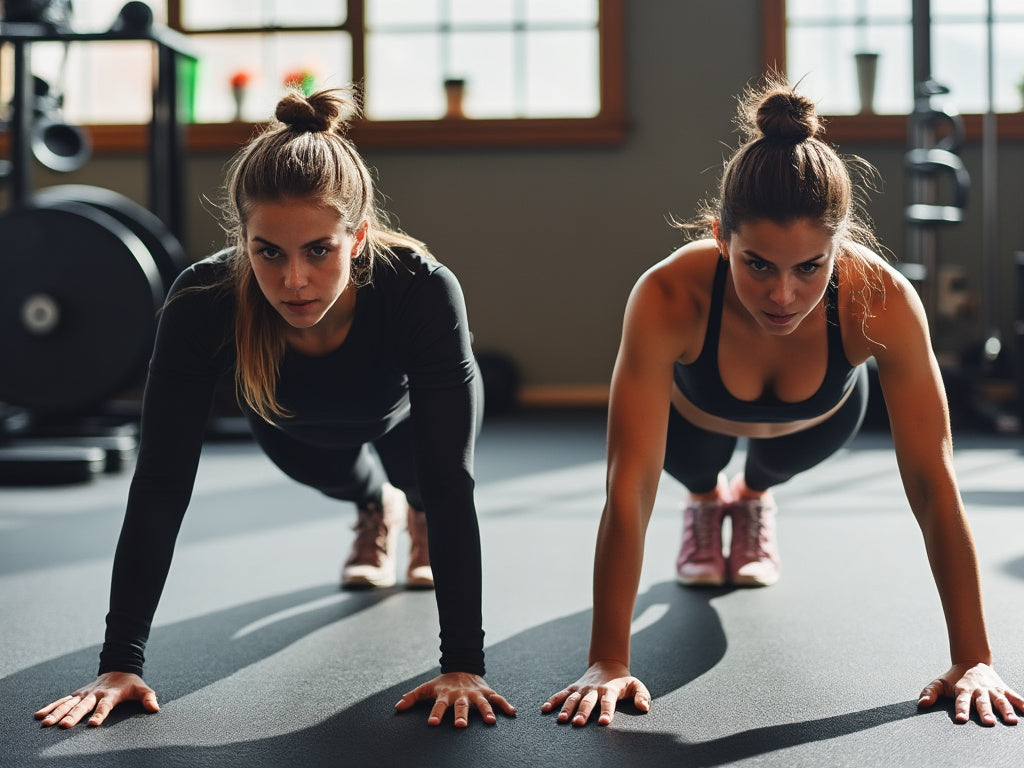¿Tienes problemas de postura durante tus entrenamientos? En esta publicación, hablo sobre técnicas de postura correcta, calentamientos centrados en la postura y la configuración ideal de tu gimnasio en casa para mejorar tu postura al entrenar . Comparto consejos prácticos para ayudarte a reducir el dolor y evitar lesiones, garantizando una rutina de ejercicios más segura y efectiva. Sigue mi ejemplo para fortalecer tu core y cuidar tu postura mientras entrenas .
Comprenda los fundamentos de una postura correcta para el ejercicio

Reconozco errores posturales comunes durante los entrenamientos, que pueden afectar la alineación de la columna y la seguridad. Me centro en identificar la posición neutra de tu columna mientras integro ejercicios isométricos y técnicas de yoga con acero resistente y equipo de cuerdas confiable. Esto sienta las bases para establecer hábitos posturales sólidos, lo que garantiza el éxito en tu rutina de gimnasio en casa.
Reconozca los errores posturales comunes durante los entrenamientos
He visto cómo una alineación incorrecta durante el entrenamiento puede causar tensión desigual en la rodilla y los grupos musculares . Recomiendo revisar la técnica de prensa de piernas y asegurar una distribución equilibrada del peso para evitar una presión excesiva.
En mi experiencia, prestar atención a la postura durante el ejercicio ayuda a evitar errores que pueden provocar distensiones en la rodilla u otros grupos musculares . He comprobado que ajustar la postura durante el entrenamiento refuerza la técnica correcta y mejora el rendimiento general.
Aprecie el vínculo entre la alineación de la columna vertebral y la seguridad en el entrenamiento
He notado que una correcta posición de la columna vertebral es fundamental para la seguridad en el ejercicio , especialmente al utilizar diversos equipos, como un banco de pesas o un escritorio resistente, para ejercicios de apoyo. Concentrarme en controlar la respiración y en una posición firme de las piernas me ayuda a mantener una curvatura espinal natural que minimiza el estrés y favorece una postura equilibrada durante los entrenamientos.
Mantener una correcta alineación de la columna vertebral es una forma práctica de prevenir molestias al levantar pesas o realizar otros ejercicios . Considero que integrar técnicas de respiración constantes con un control cuidadoso de la posición de piernas y brazos me permite ejecutar movimientos de forma segura y eficaz, lo que garantiza un progreso sostenible en mi camino hacia el fitness .
Identifique la posición neutra de su columna
Coloco la pelvis con cuidado y uso un rodillo de espuma para comprobar la alineación antes de cada sesión de ejercicio , asegurándome de que mi columna esté bien neutra para realizar las repeticiones correctas con una banda de resistencia . Este método me ayuda a mantener una postura equilibrada al realizar ejercicios de fuerza y estabilidad.
Mi enfoque consiste en activar suavemente el torso para estabilizar la pelvis y controlar mis movimientos durante cada ejercicio . Suelo incorporar una banda de resistencia a mi rutina para reforzar la postura correcta y garantizar que cada repetición mantenga una columna neutra y una postura alineada.
Establezca buenos hábitos posturales para tener éxito en el gimnasio en casa
Me centro en desarrollar hábitos posturales que favorezcan mis entrenamientos en el gimnasio en casa y minimicen la tensión al usar equipos como un sistema de poleas para el entrenamiento de fuerza . Me aseguro de que mis tríceps y espalda se mantengan alineados durante cada ejercicio , lo que favorece una postura correcta y maximiza la eficiencia del entrenamiento .
Monitoreo constantemente mi postura al realizar ejercicios de fuerza , utilizando equipos que ayudan a mantener la estabilidad del core y una alineación correcta. Experimento menos problemas posturales al ajustar mi postura y activar los músculos de la espalda , lo que a su vez mejora mi rendimiento general en los entrenamientos .
Domina la forma adecuada para proteger tu postura
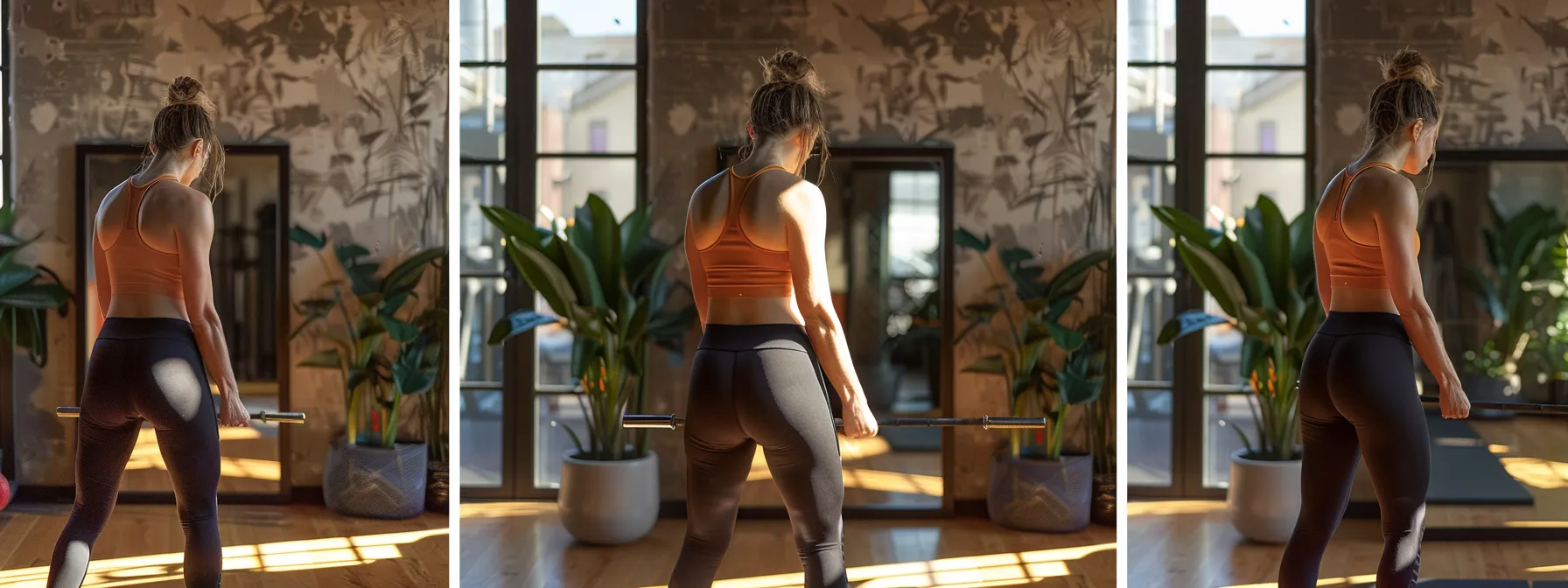
Me concentro en la profundidad adecuada de las sentadillas y la alineación de la columna, manteniendo la espalda recta durante los pesos muertos y los remos. Alineo mi cuerpo para las flexiones y las planchas, controlo el movimiento de los omóplatos en los ejercicios de tracción y estabilizo el torso durante los press de hombros. Comparto conocimientos sobre entrenamiento femenino , rutinas de pilates , control de codos , flexibilidad y seguridad costal .
Consiga una profundidad de sentadilla correcta y una alineación espinal correcta
Me concentro en mantener una sentadilla equilibrada contrayendo el glúteo mayor y estabilizando los músculos durante todo el ejercicio , asegurándome de que el muslo y el torso se alineen correctamente para mantener la curvatura natural de la columna. Utilizo movimientos controlados para imitar los patrones de la marcha , lo que me ayuda a lograr una profundidad constante y una postura correcta, esenciales para obtener mejoras duraderas en mi condición física .
Superviso mi técnica de sentadillas con diligencia, utilizando ajustes precisos para mantener la columna en posición neutra y activar el glúteo mayor para mayor soporte. Al incorporar sentadillas lentas y deliberadas a mi rutina, mejoro mi estado físico general y prevengo problemas de postura , a la vez que protejo los músculos de los muslos y la espalda durante los entrenamientos.
Mantenga la espalda plana durante los levantamientos de peso muerto y remos
Me aseguro de mantener la espalda recta durante los pesos muertos y remos, enfocándome en la activación muscular precisa y comprobando constantemente que mi barbilla esté alineada con un techo virtual, evitando así dolor innecesario durante el movimiento. Recomiendo a todos los clientes que entrenan con sentadillas o rutinas similares que se tomen el tiempo de supervisar su técnica, ya que incluso una pequeña desviación en la alineación puede causar molestias con el tiempo.
Mantengo una postura estricta, manteniendo la espalda recta y la barbilla en la posición correcta para mantener una línea corporal natural, lo que minimiza la tensión al levantar pesas pesadas. Mi enfoque, basado en mi experiencia práctica, me ha ayudado a evitar el dolor y a mejorar la estabilidad, demostrando que simples ajustes en la postura pueden generar beneficios significativos para cada cliente comprometido con objetivos de fitness duraderos.
Alinea tu cuerpo correctamente para hacer flexiones y planchas
Mantengo mi cuerpo alineado durante las flexiones y las planchas, concentrándome en estabilizar las caderas , activar los músculos de los brazos y asegurarme de que la caja torácica se mantenga en la posición correcta. Utilizo un enfoque basado en máquinas para perfeccionar mi técnica y suelo recomendar a mis clientes que añadan al carrito los mejores materiales de entrenamiento para fomentar una práctica constante.
Mantengo la forma concentrándome en equilibrar las caderas y en impulsar el brazo en cada movimiento para mantener la alineación correcta de la caja torácica . He notado que combinar estas técnicas con equipo de soporte me ayuda a evitar la tensión y a mejorar mi rendimiento general de forma constante.
Controlar el movimiento del omóplato en ejercicios de tracción
Me concentro en mantener los omóplatos estables durante los ejercicios de tracción, contrayendo el core y alineando el torso correctamente. Este enfoque me ayuda a evitar la tensión en el hombro al realizar movimientos como el curl de bíceps , que imitan patrones naturales de control, asegurando que mi postura se mantenga precisa desde el suelo .
Trabajando en estrecha colaboración con mi entrenador personal , he perfeccionado técnicas para controlar el movimiento del hombro , reduciendo el movimiento innecesario durante ejercicios constantes. Observo que un control cuidadoso del torso y el hombro ayuda a mantener el equilibrio y la comodidad durante cada flexión de bíceps y rutinas similares.
Estabiliza tu torso durante las prensas de hombros
Me concentro en trabajar el core y alinear correctamente la cadera y el pie durante las prensas de hombros para estabilizar el torso . Este método no solo mejora mi rendimiento en los entrenamientos , sino que también refuerza mis esfuerzos en la condición física y complementa las recomendaciones de mis sesiones de fisioterapia .
Al realizar press de hombros, mantengo un control firme apoyando firmemente el pie en el suelo y ajustando la alineación de la cadera . Esta técnica me permite realizar cada repetición de forma segura y eficiente, asegurando que mi torso se mantenga estable durante todo el entrenamiento .
Prepare su cuerpo con calentamientos centrados en la postura
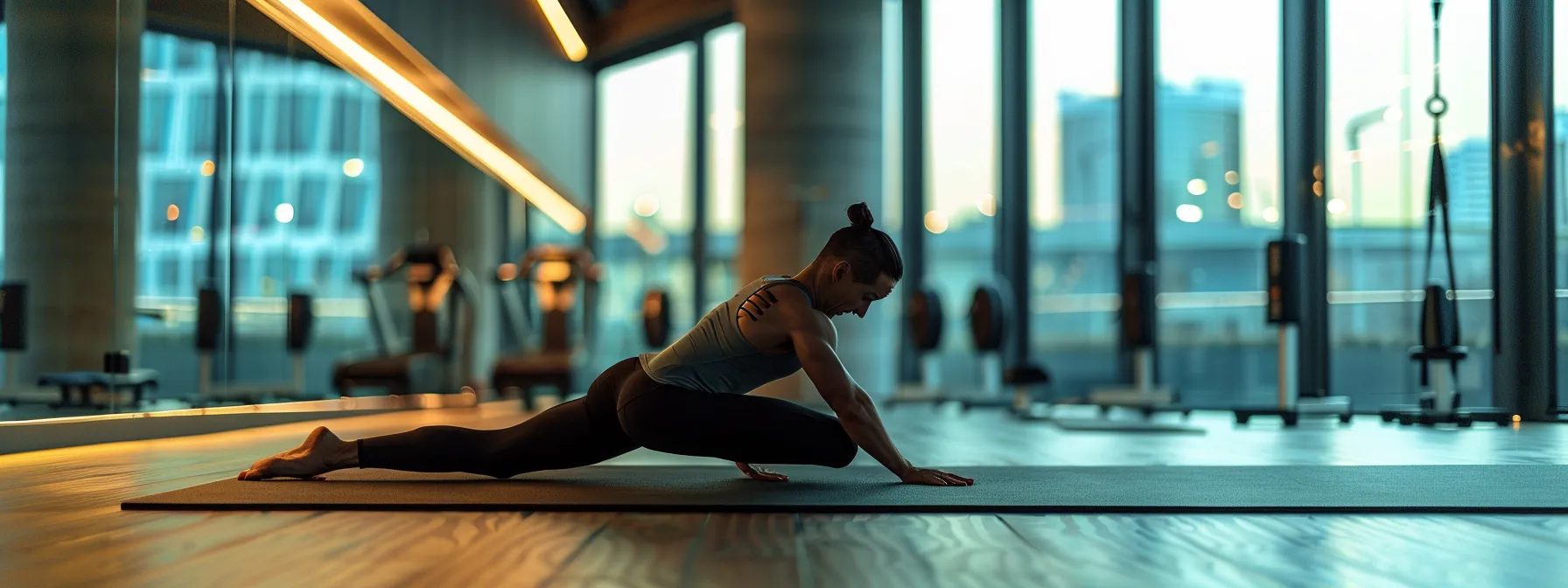
Empiezo con estiramientos dinámicos que movilizan las articulaciones y activan los músculos posturales clave para la estabilidad del core, usando una colchoneta firme. Utilizo ejercicios de movilidad para mejorar el rango de movimiento y ejercicios de equilibrio de pies a manos . Compro técnicas probadas que hacen que mi calentamiento sea simple y efectivo, reduciendo los problemas posturales durante cada entrenamiento .
Realizar estiramientos dinámicos para movilizar las articulaciones
Comienzo cada sesión con estiramientos dinámicos diseñados para movilizar mis articulaciones y preparar mis músculos para un entrenamiento equilibrado. Me centro en movimientos que involucran grupos musculares cruciales como los bíceps , a la vez que incorporo herramientas de resistencia como el equipo Bowflex para simular condiciones reales de ejercicio .
Usar movimientos controlados y activos me ayuda a calentar las articulaciones y a mantener un rango de movimiento flexible que favorece una postura correcta durante los entrenamientos . Considero que reservar el espacio adecuado para estos estiramientos dinámicos minimiza el riesgo y prepara mi cuerpo para actividades más intensas sin esfuerzo.
Activa los músculos posturales clave antes de levantar
Dedico tiempo antes de levantar pesas a activar los músculos del torso y la espalda , asegurándome de mantener una postura firme durante todo el entrenamiento . Mediante ejercicios sencillos de resistencia con equipo de fitness , preparo mi cuerpo para lograr una estabilidad constante y busco reducir la tensión durante las sesiones de entrenamiento .
Suelo incorporar rutinas de activación suaves para fortalecer mis músculos posturales, lo que me ayuda a mantener la alineación y a prevenir molestias. Este enfoque práctico me permite mejorar la calidad de mi entrenamiento y lograr una sesión equilibrada en cada sesión.
Utilice ejercicios de movilidad para un mejor rango de movimiento
Utilizo ejercicios de movilidad para aumentar mi rango de movimiento, lo que me ayuda a mantener una postura correcta durante el entrenamiento y minimiza el estrés durante los movimientos. He descubierto que los ejercicios de movilidad constantes, como balanceos suaves de piernas y rotaciones controladas de brazos , preparan mi cuerpo para el entrenamiento completo, asegurando que las articulaciones y los músculos trabajen en armonía.
En mi experiencia, integrar ejercicios de movilidad en mi rutina de calentamiento resulta práctico para lograr transiciones más fluidas entre ejercicios. Con frecuencia incorporo estiramientos sencillos que se centran en el movimiento dinámico y reducen el riesgo de lesiones, lo que refuerza significativamente mi estrategia general de acondicionamiento físico .
Incorporar ejercicios de equilibrio para la estabilidad
Integro ejercicios de equilibrio en mi rutina de calentamiento para desarrollar estabilidad y mantener una postura saludable durante los entrenamientos. Me centro en movimientos controlados que fortalecen mi torso y reducen la tensión, asegurándome de que cada sesión comience con una base sólida que favorezca una alineación constante.
Utilizo ejercicios de equilibrio sencillos que mejoran mi coordinación y control corporal mientras me preparo para un entrenamiento más intensivo. Incorporarlos me ayuda a ser consciente de mi postura y minimiza el riesgo de desalineación, lo que contribuye a una experiencia de entrenamiento más fluida y segura.
Fortalece tu core para una mejor postura al entrenar
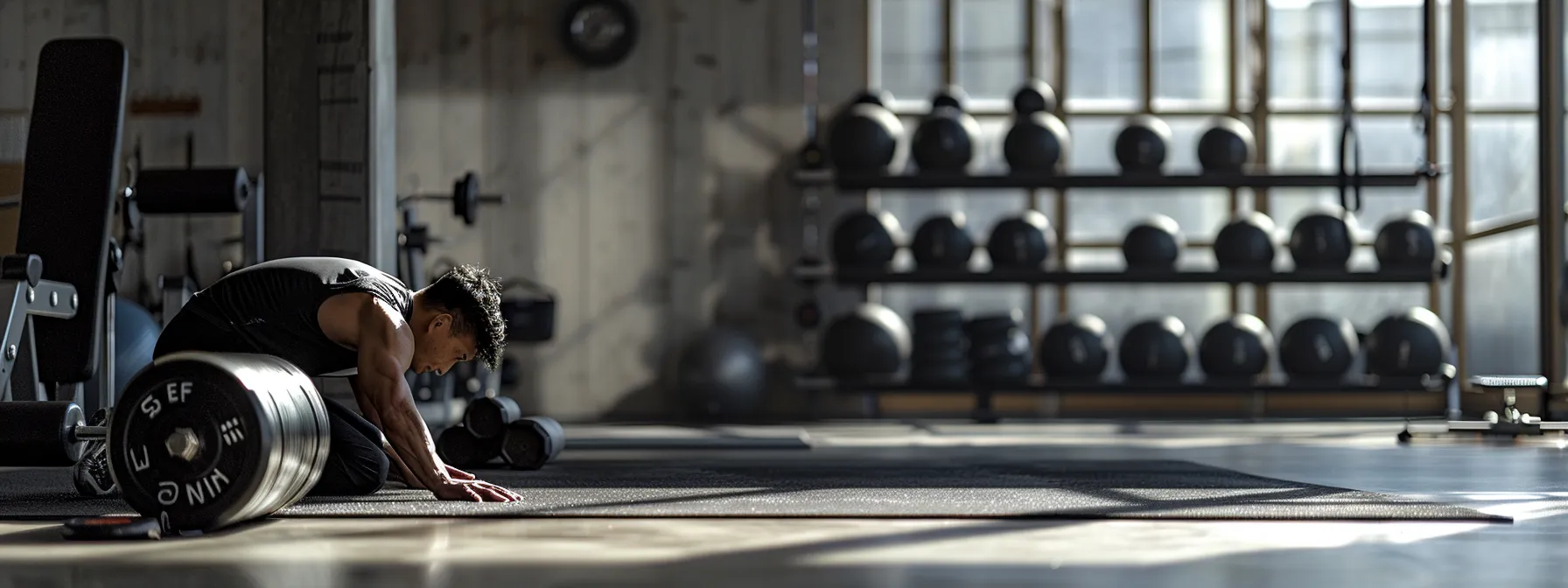
Trabajo para trabajar la musculatura abdominal profunda a la vez que desarrollo la resistencia de los extensores de la espalda para el soporte de la columna. Integro ejercicios antirrotación y practico técnicas de refuerzo del core durante los levantamientos, aplicando los principios de estabilidad del core de los entrenamientos Illumino360 para prevenir problemas posturales durante el ejercicio . Este enfoque refuerza la fuerza y el equilibrio para una experiencia de entrenamiento más segura.
Ejercite eficazmente los músculos abdominales profundos
Suelo concentrarme en trabajar los músculos abdominales profundos mediante entrenamiento de resistencia controlado que enfatiza la respiración adecuada y el movimiento constante. He descubierto que activar estos músculos del core de forma constante mientras uso equipo de fitness crea una base sólida que favorece una postura correcta y reduce la tensión durante los entrenamientos.
Mi rutina incluye ejercicios específicos que promueven la estabilidad del core , asegurando que mi zona abdominal se mantenga activa durante cada repetición. Me baso en una técnica precisa y ajustes conscientes para mantener la alineación del core, lo que a su vez me ayuda a prevenir problemas de postura y contribuye al éxito a largo plazo del entrenamiento .
Reconstruya la resistencia de los extensores para el soporte espinal
Entreno los extensores de la espalda con ejercicios de resistencia específicos que favorecen una correcta alineación de la columna durante los entrenamientos. Mediante rutinas sencillas pero estructuradas, he mejorado mi resistencia y reducido las molestias al levantar pesas.
Me concentro en mantener una postura firme mientras trabajo los músculos de la espalda , lo que ayuda a prevenir la desalineación y la tensión durante los entrenamientos exigentes. Mi práctica continua de fortalecer estos músculos ha mejorado notablemente mi postura al entrenar y mi comodidad general.
Integre ejercicios antirrotación en su rutina
Incorporo ejercicios antirrotación a mi rutina, centrándome en movimientos controlados que desafían la estabilidad del core y reducen la tensión innecesaria. Gracias a estos ejercicios, siento un abdomen más fuerte que favorece una mejor postura durante todos los entrenamientos y me ayuda a prevenir problemas comunes de alineación.
Mi enfoque incluye ejercicios antirrotación sencillos y específicos con equipo básico de fitness que me permite controlar mi postura eficazmente. He experimentado una mayor activación del core y una notable disminución de las molestias durante el entrenamiento , lo que me anima a seguir priorizando este aspecto de mi entrenamiento .
Practique técnicas de fortalecimiento del core durante los levantamientos
Me concentro en técnicas de fortalecimiento del core durante los levantamientos, activando los músculos abdominales y estabilizando el torso durante todo el movimiento. Este enfoque no solo minimiza la tensión innecesaria en la espalda , sino que también contribuye significativamente a mantener una postura correcta, haciendo que cada levantamiento sea más seguro y efectivo.
Me recuerdo constantemente que debo contraer el core antes de iniciar cualquier movimiento pesado, asegurándome de que mi cuerpo se mantenga alineado durante cada levantamiento. Usar esta técnica ha mejorado mi estabilidad y reducido las molestias, ofreciendo una solución práctica a los problemas posturales comunes durante los entrenamientos.
Aplique los principios básicos de estabilidad de los entrenamientos Illumino360
Aplico los principios de estabilidad del core de los entrenamientos Illumino360, trabajando los músculos abdominales profundos y usando ejercicios de resistencia estructurados. Considero que este enfoque es invaluable para prevenir problemas de postura durante el entrenamiento, ayudándome a mantener una base equilibrada y segura durante cada sesión.
Basándome en mi experiencia personal, incorporo técnicas precisas de fortalecimiento del core en cada levantamiento para asegurar que mi torso se mantenga firme y alineado. Esta rutina, basada en los métodos de Illumino360, ofrece una solución práctica a los problemas comunes de fitness , haciendo que mis entrenamientos sean más seguros y efectivos.
Optimice la configuración de su gimnasio en casa para una salud postural
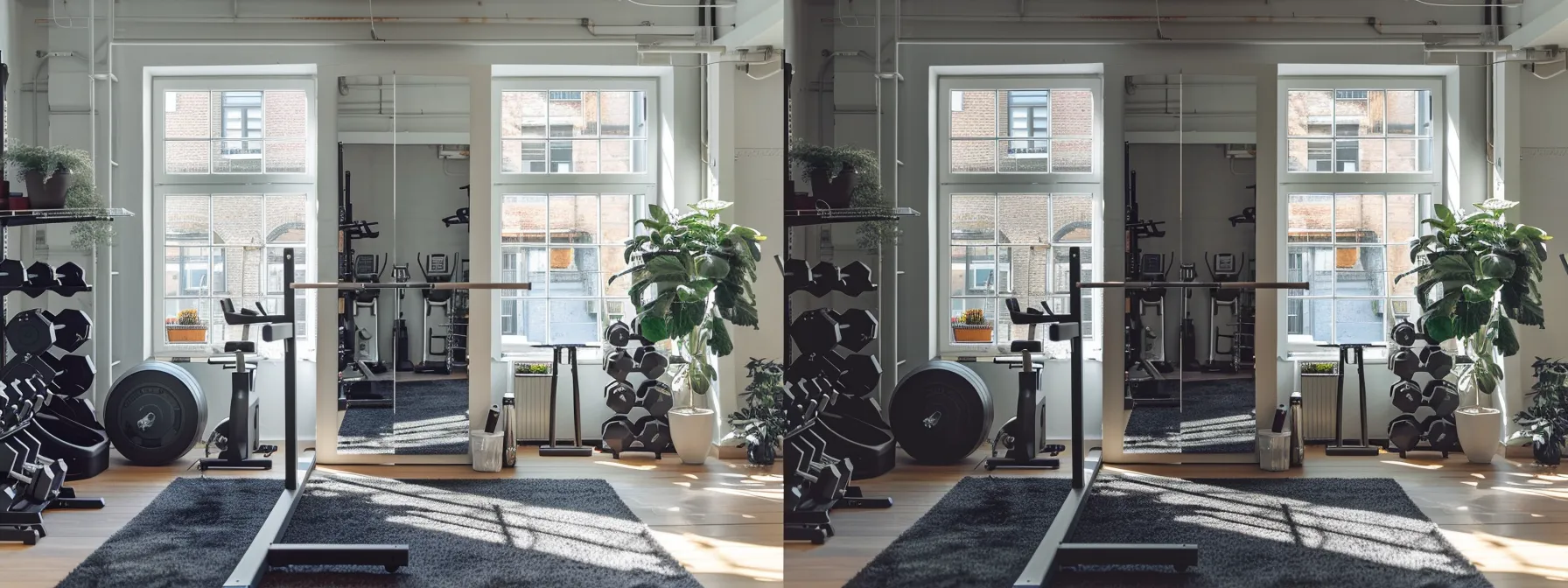
Organico el espacio de mi gimnasio en casa de forma ergonómica para favorecer una postura correcta y evitar problemas de postura . Selecciono equipos diseñados para entrenamientos equilibrados, uso espejos para obtener información en tiempo real, ajusto la configuración de las máquinas a mi cuerpo y creo rutinas que trabajan cada grupo muscular . Todas las estrategias se complementan para garantizar una salud postural óptima durante el ejercicio .
Organice su espacio de gimnasio en casa de forma ergonómica
Diseño cuidadosamente el espacio de mi gimnasio en casa para facilitar una rutina de ejercicios equilibrada, manteniendo el equipo a alturas ergonómicas y al alcance de la mano. Dispongo las pesas, las colchonetas y las máquinas para permitir un movimiento natural, asegurándome de mantener una postura correcta durante cada sesión de ejercicio .
Actualizo regularmente la distribución de mi gimnasio según mi experiencia para adaptarla a mis dimensiones corporales y estilo de entrenamiento . Me centro en crear un espacio donde cada equipo contribuya a una postura correcta y minimice el riesgo de desalineación durante los entrenamientos.
Seleccione equipos de ejercicio que favorezcan una buena forma
Selecciono cuidadosamente equipos de ejercicio que promueven una buena postura, eligiendo máquinas con ajustes ajustables y estabilidad adecuada. Priorizo equipos diseñados para entrenamientos equilibrados, asegurándome de que cada pieza mejore mi postura y reduzca el riesgo de problemas de alineación durante el entrenamiento.
Confío en equipos que me brindan información clara sobre mis movimientos, como máquinas de pesas con mangos ergonómicos y colchonetas que favorecen una alineación correcta. Usar equipos de fitness cuidadosamente diseñados me ayuda a mantener una postura correcta durante el entrenamiento y minimiza las molestias.
Utilice espejos para obtener información sobre la postura en tiempo real
Me aseguro de que mi gimnasio en casa cuente con un espejo de cuerpo entero para obtener información sobre mi postura en tiempo real durante cada sesión de ejercicio . Al observar mi postura en el espejo, puedo hacer ajustes rápidos para mantener una alineación correcta y evitar errores que puedan causar molestias.
Usar espejos se ha convertido en una parte fundamental de mi rutina de ejercicios , ya que me ayuda a controlar la posición corporal durante las sesiones de fuerza y cardio. Esta sencilla estrategia me permite concentrarme en los movimientos esenciales y mantener una postura equilibrada durante mi proceso de entrenamiento .
Ajuste la configuración de la máquina a las dimensiones de su cuerpo
Ajusto la configuración de la máquina según las dimensiones de mi cuerpo para mejorar la estabilidad durante los entrenamientos y evitar la desalineación. He descubierto que dedicar tiempo a ajustar ajustes como la altura del asiento y el respaldo me ayuda a mantener una postura correcta y a reducir las molestias.
Reviso regularmente que el equipo se adapte a mis proporciones físicas, asegurándome de que cada máquina se adapte a mi movimiento natural. Utilizo este método para mejorar la eficiencia de mis entrenamientos y abordar cualquier problema postural de forma proactiva, haciendo que mi rutina en el gimnasio en casa sea más segura.
Crea rutinas equilibradas que aborden todos los grupos musculares
Diseñé mis rutinas de entrenamiento para trabajar todos los grupos musculares , asegurándome de que mis ejercicios se enfoquen en la fuerza del tren superior, inferior y del torso. Creo en equilibrar mis sesiones de entrenamiento para no descuidar ninguna zona, lo que ayuda a prevenir problemas de postura con el tiempo.
Adapto regularmente mis rutinas de gimnasio en casa para mantener la estabilidad y promover el equilibrio muscular general durante el entrenamiento . Me centro en crear sesiones que favorezcan una alineación adecuada y mejoren la eficiencia del entrenamiento , abordando cualquier problema antes de que se convierta en molestia.
Reconocer y abordar los problemas de postura durante el entrenamiento

Me concentro en autoevaluar mi técnica, detectar señales de alerta durante los entrenamientos y ajustar los ejercicios cuando es necesario. Reviso si tengo limitaciones posturales y determino cuándo buscar ayuda profesional. También integro ejercicios correctivos en mi plan de acondicionamiento físico para complementar mi entrenamiento y prevenir lesiones.
Aprenda métodos de autoevaluación para la verificación de formularios
Utilizo técnicas sencillas para autoevaluar mi técnica de entrenamiento : registro algunas series y reviso mi alineación frente al espejo, lo que me asegura detectar cualquier desviación a tiempo. Este enfoque me permite realizar ajustes en tiempo real que reducen la tensión y previenen problemas posturales durante el entrenamiento de fuerza .
He descubierto que emplear métodos de autoevaluación, como grabar videos periódicamente de mi rutina, me proporciona una visión honesta de mi alineación. Estas comprobaciones prácticas me ayudan a mantener la estabilidad y a mantener una postura correcta, lo que me da la confianza de que mi técnica de entrenamiento sigue siendo la correcta.
Detecta señales de advertencia de mala postura durante el ejercicio
He observado que las molestias repentinas en el cuello o los hombros suelen indicar una alteración de la postura correcta durante mis entrenamientos . Me concentro en monitorear estas áreas en tiempo real, asegurándome de que mi alineación se mantenga constante para evitar cualquier distensión muscular .
He notado que si mi movimiento se vuelve inestable y aparecen patrones de compensación, ajusto mi ejercicio inmediatamente. Me baso en una retroalimentación visual clara y en comprobaciones regulares de la conciencia corporal para asegurarme de que cada repetición mantenga una postura equilibrada y segura durante toda mi rutina de ejercicios .
Modificar los ejercicios para adaptarse a las limitaciones posturales
Adapto mis ejercicios a mis limitaciones posturales específicas, recalibrando el rango de movimiento y reduciendo la carga durante los movimientos intensos, asegurando una postura segura y sin dolor . Me baso en modificaciones prácticas, como reducir la velocidad de repetición o sustituir movimientos, para mantener la estabilidad del core y proteger mi postura durante cada sesión de entrenamiento .
Modifico mi rutina experimentando con diferentes ángulos y niveles de resistencia que se adaptan a las necesidades de mi cuerpo, sin dejar de ejercitar mis músculos eficazmente. Incorporo estos ajustes personalizados en los ejercicios para favorecer el equilibrio y evitar molestias, haciendo que mi equipo de entrenamiento se adapte a mis necesidades físicas.
Entender cuándo es necesaria la orientación profesional
He aprendido que cuando las molestias posturales persisten a pesar de ajustar mi postura, es momento de buscar el consejo de un profesional certificado, como un entrenador físico o un terapeuta. Confío en la guía de un experto para perfeccionar mi técnica y adaptar los ejercicios a mis necesidades específicas, garantizando así que mi entrenamiento sea seguro y efectivo.
Suelo supervisar mi cuerpo de cerca durante el entrenamiento y, cuando noto dolor o desalineación recurrentes, consulto con un especialista que puede ofrecer correcciones prácticas. Contar con apoyo profesional me ha ayudado a identificar sutiles desviaciones en la postura y a realizar los ajustes necesarios a tiempo, lo que, en última instancia, previene problemas de postura a largo plazo.
Integre ejercicios correctivos en su plan de acondicionamiento físico
Integro ejercicios correctivos en mi plan de entrenamiento , incorporando movimientos específicos que corrigen la desalineación y mejoran la postura general durante el entrenamiento . Utilizo ajustes sencillos durante mis entrenamientos, asegurándome de que cada ejercicio mantenga la postura correcta y reduzca el riesgo de tensión muscular .
He observado que añadir ejercicios correctivos a mi rutina me ayuda a abordar problemas de postura y sienta una base sólida para un entrenamiento seguro a largo plazo. Me centro en movimientos precisos y repeticiones controladas para reforzar una buena alineación, lo que facilita mantener una sesión de entrenamiento equilibrada y segura.
Conclusión
Me tomo muy en serio la postura durante los entrenamientos para evitar tensiones e incomodidades innecesarias. Ajuste mi postura controlando la alineación de la columna, ejercitando los músculos del core y manteniendo técnicas de ejercicio adecuadas. Integro métodos como la autoevaluación y los ejercicios correctivos en mi rutina para obtener resultados duraderos. Creo que una postura correcta sienta las bases para un mejor rendimiento y una experiencia de entrenamiento más saludable.



